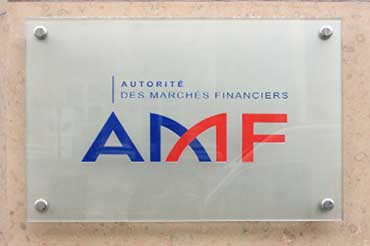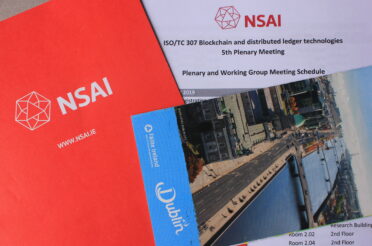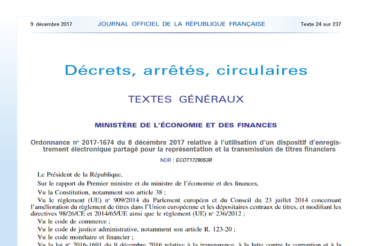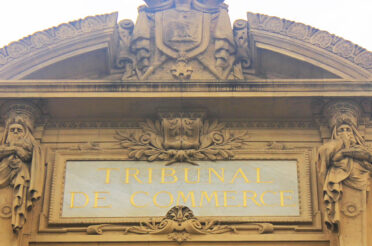The Autorité des Marchés Financiers ("AMF") published on July 3 and 20, 2017, its 2017 risk mapping (where a few pages are devoted to the specific case of blockchain) and its response to the European Commission's consultation on FinTech: "Towards a Europe of more competitive and innovative financial services". A cross-sectional look at these two documents sheds interesting light on the AMF's policy in the highly "disruptive" field of blockchains.
The AMF's policy lies somewhere between (I) supporting blockchain projects with a favorable view and (II) recognizing the need to change the applicable regulations.
I - As a supporter of innovative projects, the AMF has a generally favorable view of blockchain
The AMF's favorable view of blockchain is the result of (i) the maturation of blockchain projects and (ii) an evolution of the AMF's knowledge, which is illustrated by its willingness to adapt.
i) Maturation of blockchain projects
In its mapping, the AMF notes that the trends observed during 2016 show that "the maturation of projects calls for the financing of technical developments aimed at testing their feasibility and viability (proof of concept) in more concrete terms".
In this context, the HALDE observes a marked influence of established (often banking) players, capable of providing the necessary funds. It cites initiatives in this area by Euroclear and BNP Paribas Securities Services.
Unsurprisingly, the AMF notes the importance of "private blockchains (permissioned DLT), which apply DLT technologies to closed networks made up of identified and trusted players [...] They are part of less disruptive business models and allow for a more gradual adoption of innovative technologies."
In this overview of the evolution of risks related to economic, financial and regulatory activity, the AMF highlights the materiality of potential risks. It cites the flaw in the coding of the smart contracts of the participatory finance project The Decentralized Autonomous Organisation (DAO), which it likens to a "fund whose units are denominated in crypto-currency". The AMF states in an interesting way that "As these facts could not be qualified under the law, those who benefited from them have not been sanctioned". This remark is noteworthy in light of the recent decision of the U.S. Securities and Exchange Commission ("SEC") to consider certain DAO transactions as falling within its jurisdiction.
The AMF also mentions, in terms of risk, the case of a French FinTech that received a reprimand and a fine of €80,000 from the Autorité de contrôle prudentiel et de résolution (ACPR) for flaws in the identification of counterparties for bitcoin payments in 2014 and 2015. The ACPR blamed the company for failing to comply with the procedures required by anti-money laundering and anti-terrorist financing regulations.
The AMF's awareness of the maturation of projects is the result of the progress of the projects themselves but also of a better understanding of this technology by the high authority, marked by a willingness to adapt.
An evolution of the AMF's knowledge that is illustrated by its willingness to adapt
The proliferation of blockchain projects submitted to it has enabled the AMF to increase its expertise in the field and develop new resources both internally and externally.
In its 2017 mapping, the AMF states that the importance of financial regulatory issues regarding FinTech prompted it to create a "FinTech, Innovation and Competitiveness" division in June 2016. This division is dedicated to monitoring, and analyzing innovations as well as assessing the need for changes in regulation or doctrine in the areas concerned.
A simple reading of this document reveals a semantic evolution of certain terms used by the AMF. In its 2014 mapping, the AMF spoke of "virtual currencies" in relation to bitcoin, whereas it now speaks of "crypto-currencies", which reveals a greater mastery of the subject.
However, it is regrettable that the AMF does not make a distinction (as does the European Securities and Markets Authority) between the term blockchain and Distributed Ledger Technology (DLT). While blockchains are a particular type of DLT, not all distributed ledger technologies are blockchains.
Among the external resources, the AMF has increased its collaborations both in France and internationally.
In France, the regulatory status of financial services falls under the jurisdiction of the AMF (regarding assets and investments) and/or the Autorité de contrôle prudentiel et de résolution (ACPR) (regarding, for example, exchanges of crypto-currencies for legal tender).
The AMF and the ACPR have undertaken a joint approach to coordinate their action: to this end, they created a "FinTechs" forum in July 2016 to exchange directly with industry players.
Internationally, on March 27, 2016, the AMF signed a cooperation agreement with the Monetary Authority of Singapore ("MAS") dedicated to FinTechs. As Singapore is at the forefront of the blockchain field, this agreement can be particularly beneficial to the AMF in terms of both expertise and feedback. In this regard, it is interesting to note that the Monetary Authority of Singapore is currently studying the possibility of converting the Singapore dollar into crypto-currency issued by its central bank.
Knowledge and resources are not everything, however. The AMF observes that distributed ledger technologies represent the innovation that raises the most technical, legislative and regulatory questions.
II - The AMF notes the need to develop the applicable regulations
In the absence of an international law on blockchain, the AMF notes the need to develop the law, both at the national and European levels.
i) At the national level
At the domestic level, many FinTechs in the sector are asking regulators and public authorities for a legal guarantee in order to be able to operate in a stable legislative and regulatory context. The AMF is aware of the need to clarify French regulations in this area.
It recognizes that, "although preliminary legal analyses estimate that blockchain technologies can be used for the most part under constant law, certain application projects, particularly in the post-trade area, cannot be carried out under current regulations."
In its response to the consultation with the European Commission, the HALDE highlights the evolution of French law with the order on minibonds (securities issued by a company in return for a loan granted to it and issued by crowdfunding platforms on the blockchain) and the Sapin II law, which should allow securities of unlisted companies to be put on the blockchain.
Nevertheless, if the AMF is right to point them out, we have to admit that these modifications of the French law remain for the moment at the state of drafts. While the Sapin II law should result in the publication of an ordinance by the end of the year, minibonds are clearly behind schedule since the decree implementing the ordinance of April 28, 2016 is still awaited more than a year after its publication.
It is worth noting that the AMF mapping reveals the position of this body regarding the possibility of having a "sandbox" regulatory approach to blockchain. This approach, according to the AMF, consists of a number of foreign regulators creating a secure legal environment in which certain innovative startups, pre-selected by the supervisor, are allowed to test their products and services with real customers, while being exempt from some of the associated regulatory requirements.
The AMF is opposed to this approach, which it considers to be unequal and not within the scope of a supervisory authority. The AMF advocates appropriate and non-discriminatory regulation based on a pragmatic and evolutionary approach that would bring together traditional players developing new digital offerings and innovative projects.
The AMF stresses that it will also be necessary to "consider the normative scope of the technological choices made, in a context where, for example, certain debates have crystallized around the strategic choices (and the change in membership) of the American consortium R3 dedicated to promoting the use of DLT, and the Hyperledger project (sponsored in particular by the Linux Foundation) for the development of open source DLT standards".
ii) At the European level
In its response published on July 20, 2017, the AMF calls for European regulation of FinTechs given the transnational aspect of their operations.
A European "umbrella status" applying to all global platforms offering global investment solutions in financial instruments.
The AMF states that "certain questions raised by players using disruptive technologies deserve to be studied at the European level. This is the case, for example, with blockchain technologies, which could be the subject of an experimental field at the European level. A support system for players using these disruptive technologies could thus be envisaged and thus provide a harmonized legal response to all jurisdictions in the Union."
The AMF recognizes that most of these questions remain unanswered at the international level. A certain number of concepts specific to this technology (notably the notions of "smart contract" and "digital asset (token)") remain without legal definition.
However, it is regrettable that not once in these two documents does the AMF address the issue, which is currently being debated, of public sales of crypto assets for crypto-currencies, also known as "Initial Coin Offering" or "ICO".
In conclusion, while the AMF is generally supportive of blockchain, the regulatory tools at its disposal limit the actions of blockchain startups. Current regulations, whether national, European or international, often seem unsuitable, obsolete or even completely absent in the face of this new supranational technology that brings new answers and new practices every day. If new regulations are necessary for the development of blockchain activities, they will have to take into account the new paradigm that blockchain implies and leave a large part to flexible law (guidelines, best practices or voluntary standardization).
Sources :
– AMF – Cartographie des risques 2017
– Réponse de l’AMF à la consultation de la Commission européenne sur les FinTech
This article first appeared on: www.bitcoin.fr






